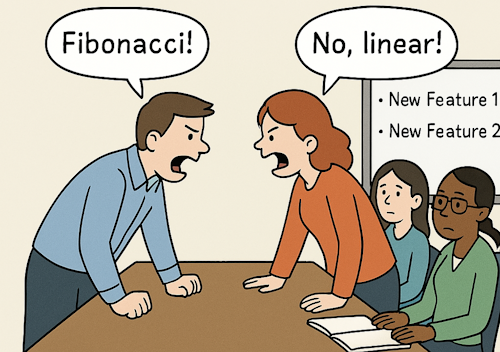Sayre's Law
Conflicts in low-stakes environments are often the most intense.
"In any dispute, the intensity of feeling is inversely proportional to the value of the issues at stake."

Though born in the world of academia, Sayre's Law reveals a universal truth about human behavior: the smaller the stakes, the louder the debate. In Agile organizations, where speed, collaboration, and feedback loops are the norm, this dynamic can quietly undermine team effectiveness. When passionate arguments erupt over estimation methods, meeting formats, or naming conventions, they often distract from the real work of delivering value. What begins as a minor disagreement can escalate, draining time, fraying relationships, and stalling momentum.
Impact on Agile Teams
Sayre's Law affects Agile environments in subtle but significant ways. It can derail team focus, compromise Sprint Goals, and create long-standing interpersonal rifts. Teams may waste valuable time debating naming conventions, story point estimates, or the format of Daily Scrums, none of which truly move the product forward. Meanwhile, critical conversations about customer outcomes, architectural trade-offs, or market risks may receive less energy or attention.
Left unchecked, these low-stakes, high-drama conflicts can degrade morale, damage trust, and undermine Agile values such as collaboration, openness, and respect.
Scenario
A Scrum team is preparing for a planning session. The Product Owner introduces two new features, each aligned with the current product strategy. However, the developers spend half the session arguing over whether to use Fibonacci or linear story point scales. Voices rise, tensions mount, and the actual features receive only cursory estimation and no technical discussion.
The planning session ends without meaningful alignment or clarity. Team members leave frustrated, not because of the features themselves, but because they felt unheard in a debate that ultimately didn't matter much.
This is Sayre's Law in action.
Ways to Mitigate Sayre's Law:
To address the effects of Sayre's Law, Agile leaders and coaches can guide teams in a few key ways:
- Cultivate Value-Focused Conversations:
Use coaching and facilitation techniques that shift attention toward customer value, strategic outcomes, and system-wide impact. Encourage teams to ask, "What will this decision change for the user?" or "How does this help us deliver value faster?"
- Set Decision Thresholds:
Establish lightweight governance for decisions. Not every issue needs full consensus or a 30-minute discussion. Introduce Working Agreements around "default decisions" for low-stakes issues, or timebox debates with a bias toward action.
- Reframe or Park Low-Impact Issues:
When emotional energy flares around trivial matters, reflect it back to the team. Ask, "Is this where we want to spend our energy today?" or suggest parking the topic for a Retrospective where cooler heads may prevail.
- Elevate What Matters:
Make space for higher-impact discussions in Retrospectives, Sprint Reviews, and Backlog Refinement. Use data, feedback, and system thinking to steer the conversation toward strategic or delivery-related challenges.
- Coach Emotional Awareness:
Help individuals recognize when intensity is disproportionate. This supports emotional intelligence, which in turn protects team cohesion.
Conclusion:
Sayre's Law reminds Agile practitioners that energy is not always rationally allocated. In the fast-paced, collaborative world of Agile development, misplaced passion can become a hidden tax on productivity and morale. The ability to recognize when a conflict stems from Sayre's Law, and to gently refocus or reframe the discussion, is a powerful coaching move. It enables teams to preserve their energy for what truly matters: creating valuable products and growing together.
Key Takeaways
- Sayre's Law highlights how emotional energy often flares around low-impact decisions.
- In Agile teams, this can stall momentum and erode psychological safety.
- Coaches should guide teams toward value-focused conversations and establish norms that prevent escalation of minor issues.
- Emotional intelligence and facilitation skills are key tools for identifying and defusing Sayre-style conflicts.
- Refocusing on purpose, outcomes, and shared goals helps teams stay aligned and resilient.
Summary
Sayre's Law, though rooted in academic humor, reveals a deep truth about human dynamics. Agile teams, especially those committed to collaboration, must be vigilant about where they invest their emotional energy. When petty debates dominate, productivity and morale suffer. Through intentional coaching, structured decision-making, and emotional awareness, Agile teams can rise above the trap of Sayre's Law and stay focused on delivering meaningful value.